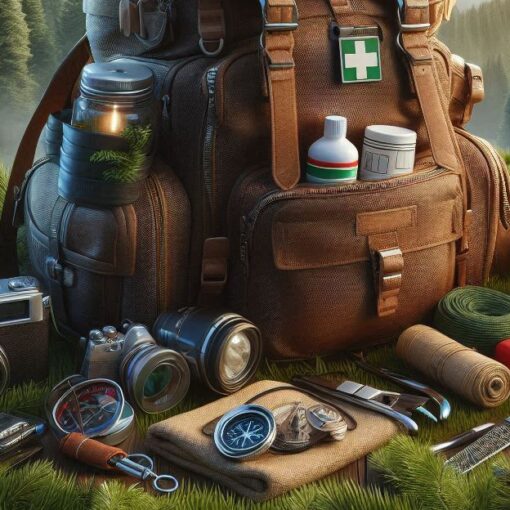Please Note: This post may contain affiliate links. If you click one of them, we may receive a commission at no extra cost to you. As an Amazon Associate, I earn from qualifying purchases.
Top Takeaways and Key Concepts
- Stay calm to think clearly and safely respond to unexpected threats in the wild.
- Assess your surroundings to identify escape routes, water sources, and safe terrain.
- Move quietly and use natural cover like trees and rocks to avoid detection.
- Create distractions with noise or thrown objects to divert threats and gain time.
- Trust your instincts and navigate to safety using landmarks, elevation, and awareness.
Summary of This Article
This article explains practical escape and evasion strategies for outdoor survival. It emphasizes staying calm during unexpected encounters, reading the environment for safety options, and using stealth to avoid detection. It also covers distraction techniques to escape danger, using cover to hide, and navigating safely back to familiar areas. With awareness, patience, and practice, anyone can stay safe and confident outdoors while turning challenges into memorable adventure stories.
Short Video Version of this Article
Imagine being in the woods and taking in all the magnificent sights and noises. Everything is going well. Then, all of a sudden, your heart starts to race like a squirrel on a caffeine high when you see something. There might be a bear that doesn’t look very friendly, or a bunch of campers who seem a little too near for comfort.
That sudden fear is quite reasonable. It happens to everyone at some point. It can help to know what to do when things get a little too exciting. So let’s talk about some simple strategies to keep calm and safe.

First, try to stay calm. Taking deep breaths can assist. You still have control. Take a look around. If it’s a bear, the most important thing to do is back away gently. Just like you, bears normally don’t want difficulty. Don’t turn your back on it. You need to watch where it goes.
Just grin and wave if it’s those campers. They could be nice! A lot of the time, talking to other people can help. If they seem lost or need help, offer to aid if you feel comfortable. But if they seem a little weird, trust your gut.
Also, think about ways to get away. Can you get up a tree or find a nice place to hide? Find areas where you feel comfortable. And don’t forget to talk. Making noise can drive animals away or get people’s attention if you need aid.
Being ready makes a big difference. When things happen that you didn’t expect, you’ll feel more in control. Nature is wonderful, but it may also surprise us. So let’s stay calm and remember that we can manage everything that comes our way.
Understanding Your Environment

First, let’s speak about why it’s important to know what’s going on around you. Knowing the land can be just as important as knowing how to make a fire (which, by the way, should never involve trying to rub two sticks together while you’re panicked).
Picture this: you’re outside, and everything seems calm. But then you remember that it’s time to actually look around. What do you see? Are there any heavy shrubs close by? A river that flows by or a comfortable cave that appears like it might be home to a bear?
It’s quite helpful to look around. Nature is like a game of hide-and-seek. That’s fantastic if there’s water around. Water can help you find your way back to people. If you follow the river, you might find a path or possibly a road. And if anything terrible is close, you want to be able to get away quickly, right?
You might also want to think about climbing up to a higher place. It lets you see better. You can see where you’re going and what might not be safe. Also, being able to see well can make you feel more brave.
I remember going hiking with a friend once. I thought he was a moose! Is it possible? I jumped back so quickly. He was merely sporting a weird hat, it turns out. Knowing what’s around you all the time can help you avoid making dumb mistakes, like thinking your pals are enormous animals!
Be on the lookout. Pay attention to the tiny things. Being attentive makes you feel safer and helps you find the best way to travel. Nature is full of surprises, yet it’s helpful to know your area well. You can do this!
The Art of Stealth

Now that we’ve covered situational awareness, let’s move on to stealth—because nothing says “I’m not here” like moving quietly through the woods.
Think of yourself as a ninja (but with less spandex and more practicality). When evading threats, sound becomes your enemy. You want to blend in with nature instead of announcing your presence like a marching band.
To achieve this ninja-like quality, practice walking softly on different surfaces. Leaves crunch underfoot like they’re auditioning for a horror movie; try stepping lightly or finding paths where foliage is sparse.
Okay, picture this. You’re out there, and you see some wildlife. Maybe a deer or a curious squirrel. Remember, animals are really good at spotting movement. If you wave your arms around, they’ll see you quicker than your friend spots a snack!
So keep it low and slow, like when you’re trying not to wake your sleepy cat. You know how they get when they’re in a deep nap. Just sneaky and careful. It makes a big difference!
And let’s talk about what you wear. Camouflage is your friend here. If you dress in earth tones—like browns and greens—you’ll blend in. It’s like being a ninja in the wild! But bright colors? Those are like wearing a sign saying, “Look over here!” Not the best idea if you’re trying to sneak past animals.
Imagine walking through the woods, and you’re just part of it. That sounds nice, right? So grab those muted clothes next time you go out. You’ll feel like you’re part of the scenery. And who knows? You might catch a glimpse of something amazing without scaring it away!
Creating Diversions

Sometimes escaping isn’t just about sneaking away quietly—it’s also about creating distractions! Imagine being chased by something big and furry only to suddenly toss out some rocks or make noise elsewhere.
That would surely buy you precious seconds while whatever was after you investigates this new development.
When you’re out there, it really helps to think ahead. Planning for distractions can be a game changer. Who doesn’t like being ready for anything? Imagine this: a little whistle could save the day. If you’re far from danger but need to grab attention, just blow that whistle. It can lead someone—or something—away from you!
I remember this one camping trip. Oh boy, what a night! Raccoons decided they wanted a party at our cooler. We tried to distract them by making noise on the other side of our camp. You won’t believe it! We knocked over the cooler while trying to shoo them away.
Suddenly, there were chips everywhere. Those raccoons went wild. They forgot all about us, just fighting over the snacks. I couldn’t stop laughing. We were safe and got to enjoy the show!
Planning distractions can save your day. But keep it safe and fun. And just maybe, you’ll end up like us, watching a raccoon food fight instead of worrying about what’s lurking in the dark!
Finding Cover

If things really go south and running isn’t an option anymore, finding cover becomes paramount. This means looking for places where threats can’t easily see or reach you—a bushy area or behind large rocks might do the trick nicely!
While hiding may seem straightforward enough, timing is everything here; waiting until the threat has moved on before emerging ensures safety first—and allows ample opportunity for dramatic storytelling later on!
Staying quiet and hidden really helps ease those nerves. You know, no one wants to end up as the story of the day—like, “Did you hear about the brave person who ran into a bear?!” It sounds better to just blend in and keep your adventures private.
I remember a time when my friend thought he could just hide behind a tree to avoid a deer. Oh boy, what a sight that was! He was crouched down like he was playing hide and seek. But deer have those big, curious eyes. They can spot movement like nobody’s business.
So, guess what? The deer just walked over all curious. It wasn’t scared at all. My friend was practically holding his breath, trying to stay still. Spoiler alert: it didn’t end well for his pride! The deer walked right up, sniffed around, then just moved on. My friend? He was left there, blushing a bright red.
Hiding can be a smart move, but sometimes it’s good to know when to laugh at yourself. Learning how to stay hidden can be fun and help keep the silly stories from happening!
Navigating Away Safely

It’s time to get back to safety after you’ve gotten away from danger and gathered your breath. You know the places we talked about? They are quite useful. Like a treasure map, use them. They can help you go home without getting lost in places that seem like a maze.
It’s important to trust your gut. Listen to that gut if something seems wrong, even if everything looks fine. Really! I can’t tell you how many times I didn’t listen to that small voice in my head. I felt like my instinct was telling me to stop, but I didn’t listen. Spoiler alert: I wish I hadn’t done it.
It can make a tremendous difference to stop and think for a second. If you ever feel uncomfortable, don’t be afraid to go back. You have the right to feel safe.
It’s also a good idea to practice how to get away. The better you know how to deal with panic attacks, the better you’ll be able to handle them when they happen. Think about how great it would be to be able to stay calm, like a superhero! It makes you feel more sure of yourself. Every little bit of practice helps. Also, it could change those dreadful buzzes in your tummy into butterflies that give you strength. Are you starting to feel like a pro? I bet you are!
Conclusion: Practice Makes Perfect
You need to practice escape and evasion skills, just like you need to practice playing the guitar. Do you remember those awkward times around the campfire? We’ve all been there, playing the wrong notes and hope no one notices. But you know what? The more you do something, the better you get at it.
Keep these things in mind when you’re outside. They could assist you out when things get a little crazy. Plus, you’ll have a lot of fun stories to tell later. Your friends will want to know why you have so many snacks with you. “Why do you have so many granola bars?” They will ask. You can tell them it’s for survival, of course. Or maybe just for great snacks while you’re out exploring!
Having everything ready makes for amazing stories. Think about how amazing it would be to tell your friends about the time you ducked beneath a branch or how a raccoon thought your cooler was its prize. Those will be the times that people will want to hear about the most.
Have fun outside. Take on the small problems. And don’t forget that every adventure teaches you something new. Who knows? You might even get other people to join in on the fun. Get those snacks and get ready to explore!
Survival in the wilderness relies heavily on staying calm, reading your environment, and making smart decisions under pressure. By using stealth, natural cover, and simple distraction techniques, you can safely avoid threats and navigate back to safety. With awareness and preparation, anyone can improve their outdoor survival confidence.
Frequently Asked Questions
How do I stay calm during a dangerous wilderness encounter?
Focus on slow breathing, assess your surroundings, and avoid sudden movements. Staying calm keeps your mind clear and helps you make smarter decisions.
What should I do if I unexpectedly encounter a wild animal?
Do not run. Back away slowly while keeping your eyes on the animal and create distance without provoking it.
How can I move without being detected in the wild?
Use quiet, smooth steps and move slowly while staying low. Follow natural cover like trees, bushes, and rocks.
What are diversion tactics and when should I use them?
Diversions are sounds or distractions used to draw attention away from you. Use them only when you need to escape safely.
Where can I hide if I need cover outdoors?
Look for thick brush, rocky outcrops, or terrain dips that break visual contact and offer protection from threats.
How do I safely navigate away from danger?
Use landmarks like rivers, ridges, or tree lines to guide movement while avoiding exposed open areas.
Why is awareness important in outdoor survival?
Awareness helps you detect threats early, choose safer routes, and react before a situation becomes dangerous.
Suggested Resources:
Survival Skills 101
https://www.survivalskills101.com
How To Build a Shelter in the Wild
https://www.wildlife.org/shelter-building-guide
Outdoor Survival Techniques
https://www.outdoorsurvivaltips.com

Kevin Collier is a seasoned outdoor enthusiast and writer for Trekbug.com, specializing in outdoor adventures, survival strategies, and prepping insights. With a deep love for nature and a commitment to self-sufficiency, Kevin empowers readers to embrace the wilderness confidently. He shares valuable tips, practical techniques, and inspiring stories, helping both novice and experienced adventurers develop essential skills for surviving and thriving in the great outdoors.





